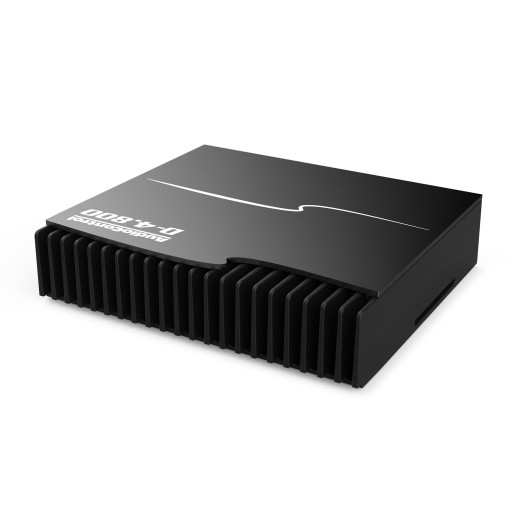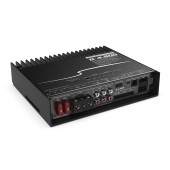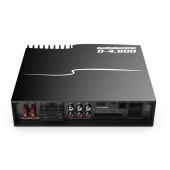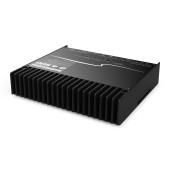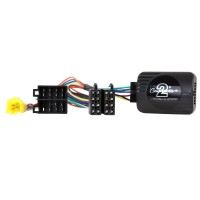AudioControl D-4.800 amplifier
More about the product
- Use our consulting room
- You can return the goods to us within 14 days
- Try the product at our store
Amplifier with DSP processor AudioControl D-4.800
Audiocontrol's award-winning amplifiers combined with the powerful processor found in the Audiocontrol DM-608 and DM-810 stand-alone DSP processors provide you with the perfect solution in one product. AudioControl Matrix DSP amplifiers include plenty of features for easy integration into a factory system such as signal summing, AccuBASS® or MILC™ along with the best sounding Class D amplification in the world, as AudioControl modestly claims. The engineers of this American manufacturer combined the award-winning technology of their amplifiers with the powerful Matrix DSP in the D-4.800. This solution provides unprecedented performance and tuning flexibility to achieve the perfect sound from your factory or aftermarket sound system. The D-4.800 features active speaker-level inputs, line-level inputs and outputs, plus AudioControl's DM Smart DSP application gives you full control over all functions including 30-band EQ, signal delay, input delay, polarity and AudioControl's own functions such as AccuBASS®, GTO™, Signal Sense, MILC™ and integrated input and output RTAs. The built-in Option Port on the D-4.800 is the future of car audio, allowing high-resolution streaming directly to the DSP. It also opens up future proprietary connections for additional inputs, drivers and interface solutions. The Audiocontrol D-4.800 combines performance and intelligent flexibility in one beautiful aluminum chassis.
Main features of the AudioControl D-4.800 amplifier
- 4-channel class D amplifier with integrated DSP processor.
- Power: 4 x 125 / 2 x 400 W RMS (4 Ω), 4 x 200 W RMS (2 Ω).
- Inputs: 4 x RCA, 6 x Hi-level.
- Outputs: 2 x RCA (8.5 V RMS).
- Input and output RTA for accurate and informed tuning.
- GTO™ signal acquisition, AccuBASS®.
- MILC™ (Maximum Input Level Control) function.
- Signal summation, signal delay.
- Crossovers 12 and 24 dB/octave.
- 30-band equalizer.
- Optional ACR-3 remote for preset recall and level control.
- Optional AC-BT24 Bluetooth streamer.
About the AudioControl brand
As the name suggests, AudioControl has been all about sound control for more than 40 years. Especially in the United States of America, AudioControl is one of the respected and very popular manufacturers not only of sound systems for vehicles, but also for homes. The company's headquarters, including research, development, manufacturing and training facilities, thrive in Mountlake Terrace, Washington, in the heart of the Pacific Northwest rainforest. All products are therefore still designed and proudly manufactured in the USA, which guarantees their high quality and reliability. This is evidenced by the five-year guarantee that AudioControl provides for its products. AudioControl engineers are responsible for several patented technologies that have created a new way to improve sound in the automotive environment. And that's exactly what AudioControl focuses on. The range is quite narrow, specializing in high-end digital amplifiers, DSP processors, equalizers, preamplifiers and, above all, a range of products for the implementation of a new sound system on existing factory units. Professional measuring tools are also available, which help to fulfill the main goal of the AudioControl company, which perfectly describes their slogan "Making good sound great".
| Catalog number | D-4.800 |
| Brand | Audio control |
| Links | Official web presentation (English) |
| Number of amplifier channelsAmplifiers are divided into: - Monoblocks - 2-channel - 3-channel - 4-channel - 5-channel - 6-channel - multi-channel Each channel is used to power one speaker for the coaxial type, or one side if they are component speakers. Monoblock type amplifiers are mainly used for subwoofers. 2-channel are suitable for both subwoofers and, for example, the front pair of speakers in a car. 3-channel is used for front or rear speakers + subwoofer. 4-channel are used for front + rear speakers or 1 pair of speakers + subwoofer. 6 or 5-channel are used for 2 pairs of speakers + subwoofer, most often. Bridging means connecting the amplifier to a bridge, using the + pole from one channel and the - pole from the other channel. In most cases this is shown as "BRIDGED" on the amplifier. | 4 |
| Energy class of the amplifierAmplifiers are divided into two basic classes: analog and digital . Analog amplifiers (A/B) have higher consumption requirements, but usually have a more natural sound. Digital amplifiers (D) have significantly lower consumption and higher efficiency, but the sound may not be as faithful as with classic analog amplifiers. | D |
| RMS power into 4 ΩRMS power when loading speakers or subwoofer at 4 Ω. RMS power is the constant power of the amplifier and is one of the most important parameters when choosing an amplifier. | 4 x 125 / 2 x 400 W |
| RMS power into 2 ΩRMS power when loading speakers or subwoofer at 2 Ω. RMS power is the constant power of the amplifier and is one of the most important parameters when choosing an amplifier. | 4 x 200W |
| Frequency rangeThe ability of the amplifier to reproduce the signal from the lowest frequency to the highest = faithfully reproduce the sound in a specific frequency band. Professionally: In the frequency range from 40 to 16,000 Hz, the vast majority of fundamental and overtones (harmonics) of all musical instruments are found. We are interested in the course of the radiated sound pressure in this range of frequencies when the loudspeaker system is supplied with constant power. We call this course the frequency characteristic, which tells us the level of radiated sound pressure in decibels (dB) depending on the frequency. The frequency characteristic of a speaker or speaker system can be expressed most succinctly with a graph. Mostly, however, the frequency characteristic is indicated by indicating the maximum tolerance of the sound pressure in the given frequency range, e.g. 50 to 15,000 Hz -+ 6 dB. Since the frequency characteristics of loudspeakers and systems in general are quite uneven, some manufacturers do not even specify this maximum tolerance of sound pressure in decibels in their catalogs for reasons of prestige. Data impoverished in this way is unfortunately worthless. What is valid is that the manufacturer offers a speaker system with a frequency range of 30 to 20,000 Hz, if he is worried about stating the maximum unevenness of the sound pressure in this range, because he can have a tolerance of, for example, +- 20 dB. The unevenness or undulation of the frequency curve in good speaker systems for high-quality music performance should not exceed +-3 dB in the 80 to 12,000 Hz band and +-6 dB in the 40 to 16,000 Hz band. Greater unevenness already depletes or emphasizes certain tonal areas, which can cause audible or even disturbing distortion. The proportion between fundamental tones and higher harmonics also changes, thereby changing the color of the sound, and individual musical instruments as well as the entire musical image sound unnatural. | 20 - 24000 Hz |
| Harmonic Distortion (THD)Total harmonic distortion indicates how much the input signal is distorted in the amplifier. Distortions appear as overtones contained in the output signal. The proportion of originally absent parts of the signal is given as a percentage, typical values are between 0.001% and 0.5%. Distortion is measured in their power band. If it exceeds the limit of 0.7% from a certain power, it is the value of the output power of the given amplifier, from which it no longer plays without distortion and from which the distortion usually increases steeply, so that no further increase in power can be counted on. The lower the value, the better. | < 0.1% |
| Signal-to-noise ratioThe signal-to-noise ratio means that the output signal always contains noise. The signal-to-noise ratio expresses how much of this noise is compared to the useful signal. The so-called A value is given, which does not take deep and very high frequencies into account. This corresponds to the characteristic of human hearing, which is not so sensitive to deep frequencies, especially below 1 kHz. The higher the value, the better the amplifier is. | 102 dB |
| High level inputsThe high-level input on the amplifier allows connection directly to the existing speakers in the car without additional purchase of an external high/low adapter. Important equipment in the case of installing an amplifier on an original car radio. | Yes |
| Automatic on and offThis function allows you to automatically switch on the amplifier. | Yes |
| Socket input terminalsFerrule terminals allow better wiring contact to the amplifier. It is also a more secure form of terminals. If you are tightening the sleeve terminals, we recommend retightening them after 1 day, as the connected cable gradually compresses. | Yes |
| Remote control included in the packageSome models of amplifiers also come with wired remote controls in the package, which on one side plug into the amplifier and on the other side you have a potentiometer that you can place anywhere in the cabin. A common place to place the remote control is under the steering wheel. The advantage is the regulation of power, and therefore volume, depending on driving conditions and the mood of the crew in the car. | No |
| Input for wired remote controlIf the amplifier has a remote control input. | Yes |
| The value of the fuses on the amplifierFrom the value of the fuses on the amplifier, you can get a true picture of the real performance of the amplifier. | 2 x 40 A |
| Dimensions of the amplifier | 228 x 203 x 53 mm |
| Mass | 2.3 Kg |
